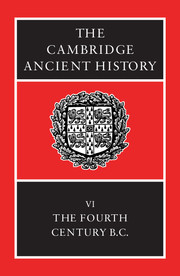Book contents
- Frontmatter
- 1 Sources and their uses
- 2 Sparta as victor
- 3 Persia
- 4 The Corinthian War
- 5 Sicily, 413–368 B.C.
- 6 The King's Peace and the Second Athenian Confederacy
- 7 Thebes in the 360s B.C.
- 8 Regional surveys I: Persian lands and neighbours
- 9 Regional surveys II: the West and North
- 10 Society and economy
- 11 The polis and the alternatives
- 12 Greek culture and science
- 13 Dion and Timoleon
- 14 Macedon and north-west Greece
- 15 Macedonian hegemony created
- 16 Alexander the Great Part 1: The events of the reign
- 17 Alexander the Great Part 2: Greece and the conquered territories
- 18 Epilogue
- Chronological Table
- BIBLIOGRAPHY
- Index
- Map 1: Greece and Western Asia Minor
- Map 9: Egypt
- Map 20: Alexanders campaigns
- References
3 - Persia
Published online by Cambridge University Press: 28 March 2008
- Frontmatter
- 1 Sources and their uses
- 2 Sparta as victor
- 3 Persia
- 4 The Corinthian War
- 5 Sicily, 413–368 B.C.
- 6 The King's Peace and the Second Athenian Confederacy
- 7 Thebes in the 360s B.C.
- 8 Regional surveys I: Persian lands and neighbours
- 9 Regional surveys II: the West and North
- 10 Society and economy
- 11 The polis and the alternatives
- 12 Greek culture and science
- 13 Dion and Timoleon
- 14 Macedon and north-west Greece
- 15 Macedonian hegemony created
- 16 Alexander the Great Part 1: The events of the reign
- 17 Alexander the Great Part 2: Greece and the conquered territories
- 18 Epilogue
- Chronological Table
- BIBLIOGRAPHY
- Index
- Map 1: Greece and Western Asia Minor
- Map 9: Egypt
- Map 20: Alexanders campaigns
- References
Summary
INTRODUCTION
Problems of method and evidence make it particularly difficult to write a history of Persia in the fourth century B.C., or rather, an account of Persia which will fit satisfactorily into a general history of a century whose study has traditionally been dominated by Greek evidence, or evidence perceived as Greek.
There are two main, related, difficulties. The first is the risk of ‘hellenocentricity’ – that is, the adoption of an unduly Greek viewpoint. This fault is easier to identify than to avoid. Nor would it be right to avoid it in all areas, for instance the military: the extensive Persian use of Greek infantry soldiers means that there will always be one Greek dimension to the study of fourth-century Persia. To the general charge of hellenocentricity, the traditionalist might reply that the dominance, in the relevant modern studies, of Greek evidence is the result not of cultural bias, but of a recognition of the quantity and quality of that evidence. In the same way the existence of Thucydides’ text makes it possible to talk about the Peloponnesian War in far greater depth and detail than about the eighth-century Lelantine or the third-century Chremonidean Wars, for neither of which is a text as rich as Thucydides available. This does not prove scholarly ‘bias’ against the eighth century, or the third. Students have tended to fasten on the Greek evidence because the Persian period seems in some respects (for instance, in the archaeological record) curiously invisible. On the other hand, it can be argued that in the relevant areas of study, which include art and iconography, the very distinction between ‘Greek’ and ‘Persian’ evidence needs to be re-assessed, and that the apparently meagre impact of Persia on the culture of the western satrapies was the result of deliberate policy: the Persians deliberately tried to play down their own power.
- Type
- Chapter
- Information
- The Cambridge Ancient History , pp. 45 - 96Publisher: Cambridge University PressPrint publication year: 1994
References
- 21
- Cited by

